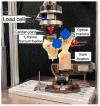Is a Washer a Mandatory Component in Young Trauma Patients with S1-S2 Iliosacral Screw Fixation of Posterior Pelvis Ring Injuries? A Biomechanical Study
- PMID: 37629669
- PMCID: PMC10456504
- DOI: 10.3390/medicina59081379
Is a Washer a Mandatory Component in Young Trauma Patients with S1-S2 Iliosacral Screw Fixation of Posterior Pelvis Ring Injuries? A Biomechanical Study
Abstract
Background and purpose: Cannulated screws are standard implants for percutaneous fixa-tion of posterior pelvis ring injuries. The choice of whether to use these screws in combination with a washer is still undecided. The aim of this study was to evaluate the biomechanical competence of S1-S2 sacroiliac (SI) screw fixation with and without using a washer across three different screw designs. Material and Methods: Twenty-four composite pelvises were used and an SI joint injury type APC III according to the Young and Burgess classification was simulated. Fixation of the posterior pelvis ring was performed using either partially threaded short screws, fully threaded short screws, or fully threaded long transsacral screws. Biomechanical testing was performed under progressively increasing cyclic loading until failure, with monitoring of the intersegmental and bone-implant movements via motion tracking. Results: The number of cycles to failure and the corresponding load at failure (N) were significantly higher for the fully threaded short screws with a washer (3972 ± 600/398.6 ± 30.0) versus its counterpart without a washer (2993 ± 527/349.7 ± 26.4), p = 0.026. In contrast, these two parameters did not reveal any significant differences when comparing fixations with and without a washer using either partially threaded short of fully threaded long transsacral screws, p ≥ 0.359. Conclusions: From a biomechanical perspective, a washer could be optional when using partially threaded short or fully threaded long transsacral S1-S2 screws for treatment of posterior pelvis ring injuries in young trauma patients. Yet, the omission of the washer in fully threaded short screws could lead to a significant diminished biomechanical stability.
Keywords: S1-S2 sacroiliac screw fixation; biomechanics; motion tracking; posterior pelvis ring injury; synthetic pelvic bone model; transsacral fixation; washer; washerless.
Conflict of interest statement
The authors declare no conflict of interest.
Figures



Similar articles
-
Evaluation of Cannulated Compression Headless Screw (CCHS) as an alternative implant in comparison to standard S1-S2 screw fixation of the posterior pelvis ring: a biomechanical study.BMC Musculoskelet Disord. 2023 Mar 23;24(1):215. doi: 10.1186/s12891-023-06312-1. BMC Musculoskelet Disord. 2023. PMID: 36949409 Free PMC article.
-
Cerclage augmentation of S1-S2 transsacral screw fixation in osteoporotic posterior pelvis ring injuries: A biomechanical feasibility study.J Orthop Res. 2023 Dec;41(12):2740-2748. doi: 10.1002/jor.25634. Epub 2023 Jun 11. J Orthop Res. 2023. PMID: 37246496
-
Do Transsacral-transiliac Screws Across Uninjured Sacroiliac Joints Affect Pain and Functional Outcomes in Trauma Patients?Clin Orthop Relat Res. 2016 Jun;474(6):1417-21. doi: 10.1007/s11999-015-4596-z. Clin Orthop Relat Res. 2016. PMID: 26472585 Free PMC article.
-
Supplemental S1 fixation for type C pelvic ring injuries: biomechanical study of a long iliosacral versus a transsacral screw.J Orthop Traumatol. 2015 Dec;16(4):293-300. doi: 10.1007/s10195-015-0357-8. Epub 2015 May 31. J Orthop Traumatol. 2015. PMID: 26026285 Free PMC article.
-
Do Fully Threaded Transiliac-Transsacral Screws Improve Mechanical Stability of Vertically Unstable Pelvic Fractures? A Cadaveric Biomechanical Analysis.J Orthop Trauma. 2021 Jan 1;35(1):e18-e24. doi: 10.1097/BOT.0000000000001857. J Orthop Trauma. 2021. PMID: 32833697
References
-
- Dilogo I.H., Satria O., Fiolin J. Internal fixation of S1-S3 iliosacral screws and pubic screw as the best configuration for unstable pelvic fracture with unilateral vertical sacral fracture (AO type C1.3): A biomechanical study. J. Orthop. Surg. 2017;25:2309499017690985. doi: 10.1177/2309499017690985. - DOI - PubMed
-
- Johnson N.L., Galuppo L.D., Stover S.M., Taylor K.T. An in vitro biomechanical comparison of the insertion variables and pullout mechanical properties of AO 6.5-mm standard cancellous and 7.3-mm self-tapping, cannulated bone screws in foal femoral bone. Vet. Surg. 2004;33:691–698. doi: 10.1111/j.1532-950x.2004.04093.x. - DOI - PubMed
MeSH terms
LinkOut - more resources
Full Text Sources

